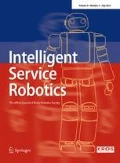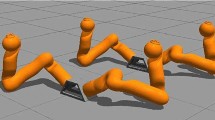Abstract
From the perspective of kinematics, dual-arm manipulation in robots differs from single-arm manipulation in that it requires high dexterity in a specific region of the manipulator’s workspace. This feature has motivated research on the specialized design of manipulators for dual-arm robots. These recently introduced robots often utilize a shoulder structure with a tilted angle of some magnitude. The tilted shoulder yields better kinematic performance for dual-arm manipulation, such as a wider common workspace for each arm. However, this method tends to reduce total workspace volume, which results in lower kinematic performance for single-arm tasks in the outer region of the workspace. To overcome this trade-off, the authors of this study propose a design for a dual-arm robot with a biologically inspired four degree-of-freedom shoulder mechanism. This study analyzes the kinematic performance of the proposed design and compares it with that of a conventional dual-arm robot from the perspective of workspace and single-/dual-arm manipulability. The comparative analysis revealed that the proposed structure can significantly enhance single- and dual-arm kinematic performance in comparison with conventional dual-arm structures. This superior kinematic performance was verified through experiments, which showed that the proposed method required shorter settling time and trajectory-following performance than the conventional dual-arm robot.
















Similar content being viewed by others
References
Asfour T, Regenstein K, Azad P, Schröder J, Bierbaum A, Vahrenkamp N, Dillmann R (2006) ARMAR-III: an integrated humanoid platform for sensory-motor control. In: IEEE-RAS Int. Conf. Humanoid Robots, pp 169–175
Do HM, Park C, Kyung J-H (2012) Dual arm robot for packaging and assembling of IT products. In: Int. conf. automation science and engineering (CASE), pp 1067–1070
Hirose M, Ogawa K (2007) Honda humanoid robots development. Philos Trans R Soc Lond A Math Phys Eng Sci 365(1850):11–19
Park I-W, Kim J-Y, Oh J-H (2005) Mechanical design of humanoid robot platform KHR-3 (KAIST Humanoid Robot 3: HUBO). In: IEEE-RAS int. conf. humanoid robots, pp 321–326
Oh J-H, Hanson D, Kim W-S, Han IY, Kim J-Y, Park I-W (2006) Design of android type humanoid robot Albert HUBO. In: IEEE/RSJ int. conf. intelligent robots and systems, pp 1428–1433
Lo S-Y, Huang H-P (2016) Realization of sign language motion using a dual-arm/hand humanoid robot. Intell Serv Robot 9(4):333–345
Kaneko K, Harada K, Kanehiro F, Miyamori G, Akachi K (2008) Humanoid robot HRP-3. In: IEEE/RSJ int. conf. intelligent robots and systems (IROS), pp 2471–2478
Kaneko K, Kanehiro F, Morisawa M, Akachi K, Miyamori G, Hayashi A, Kanehira N (2011) Humanoid robotics platform with lightweight and slim body. In: IEEE/RSJ int. conf. intelligent robots and systems (IROS), pp 4400–4407
Bagheri M, Ajoudani A, Lee J, Caldwell DG, Tsagarakis NG (2015) Kinematic analysis and design considerations for optimal base frame arrangement of humanioid shoulders. In: IEEE int. conf. robotics and automation (ICRA), pp 2710–2715
Borst C et al (2009) Rollin’ Justin-mobile platform with variable base. In: IEEE int. conf. robotics and automation, pp 1597–1598
Loughlin C, Albu-Schäffer A, Haddadin S, Ott C, Stemmer A, Wimböck T, Hirzinger G (2007) The DLR lightweight robot: design and control concepts for forbots in human environments. Ind Robot Int J 34(5):376–385
Goehler C (2007) Design of a humanoid shoulder-elbow complex. Ph.D. Dissertation, University of Notre Dame
Yoshikawa T (1985) Manipulability of robotic mechanisms. Int J Robot Res 4(2):3–9
Lee S (1989) Dual redundant arm configuration optimization with task-oriented dual arm manipulatability. IEEE Trans Robot Autom 5(1):78–97
Choi M-H, Lee M-Y, Lee B-H (1990) On the manipulability measure of dual arm. In: Korea Automatic Control Conference (KACC), pp 1156–1161
Choi M-H, Lee B-H, Ko M-S (1993) Force ellipsoid and manipulability ellipsoid of two cooperating robots. J KIEE 6(2):52–60
Bae J-H, Park S-W, Par J-H, Baeg M-H, Kim D, Oh S-R (2012) Development of a low cost anthropomorphic robot hand with high capability. In: IEEE/RSJ int. conf. intelligent robots and systems (IROS), pp 4776–4782
Bae J-H, Park S-W, Kim D, Baeg M-H, Oh S-R (2012) A grasp strategy with the geometric centroid of a groped object shape derived from contact spots. In: IEEE int. conf. robotics and automation (ICRA), pp 3798–3804
Cheah C-C (2008) Task-space PD control of robot manipulators: unified analysis and duality property. Int J Robot Res 27(10):1152–1170
Sciavicco L, Siciliano B (1996) Modeling and control of robot manipulators. McGraw-Hill, New York
Kim JT, Lee J, Kim H, Seo J, Chon S-U, Park B, Park S, Cho J (2016) Method for improving the position precision of a hydraulic robot arm: dual virtual springdamper controller. Intell Serv Robot 9(2):93–99
Arimoto S, Sekimoto M, Hashiguchi H, Ozawa R (2005) Natural resolution of ill-posedness of inverse kinematics for redundant robots: a challenge to Bernstein’s degrees-of-freedom problem. Adv Robot 19(4):401–434
Arimoto S (1996) Control theory of nonlinear mechanical systems. Oxford University Press, Inc., Oxford
Bae J-H, Park J-H, Oh Y, Kim D, Choi Y, Yang W (2015) Task space control considering passive muscle stiffness for redundant robotic arms. Intell Serv Robot 8(2):93–104
Acknowledgements
This research was supported by Basic Science Research Program through the National Research Foundation of Korea (NRF) funded by the Ministry of Education (2016R1A6A3A04012911).
Author information
Authors and Affiliations
Corresponding author
Electronic supplementary material
Below is the link to the electronic supplementary material.
Supplementary material 1 (mp4 18429 KB)
Supplementary material 2 (mp4 20707 KB)
Rights and permissions
About this article
Cite this article
Lee, DH., Park, H., Park, JH. et al. Design of an anthropomorphic dual-arm robot with biologically inspired 8-DOF arms. Intel Serv Robotics 10, 137–148 (2017). https://doi.org/10.1007/s11370-017-0215-z
Received:
Accepted:
Published:
Issue Date:
DOI: https://doi.org/10.1007/s11370-017-0215-z




